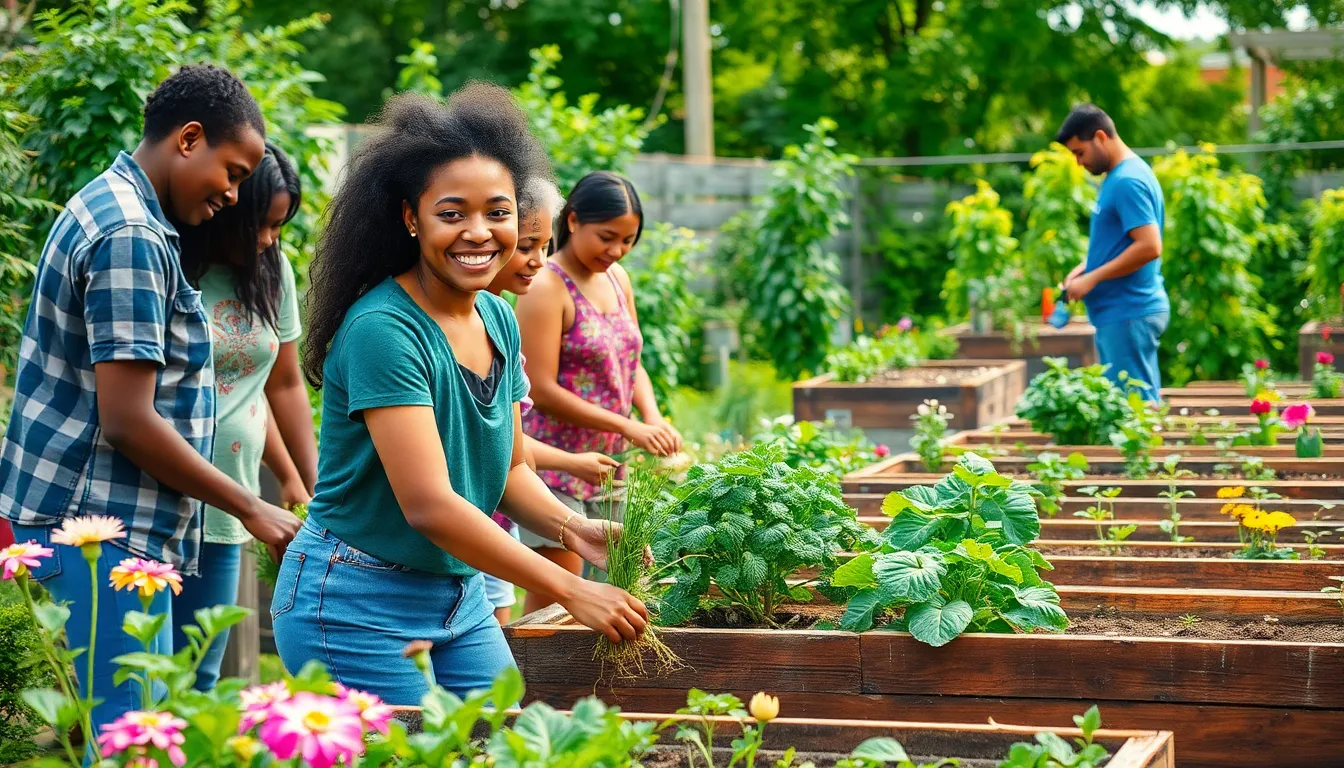In a world where plastic seems to multiply faster than rabbits, sustainable living practices are more than just a trendy hashtag—they’re a necessity. Imagine a life where your morning coffee doesn’t come with a side of guilt, and your eco-friendly choices make you the superhero of your neighborhood. It’s time to swap those single-use bags for reusable ones and embrace a lifestyle that not only feels good but also does good.
Sustainable living isn’t just about hugging trees and chanting in the woods. It’s about making small, impactful changes that can lead to a healthier planet and a happier you. Whether it’s composting your kitchen scraps or trading in your gas-guzzler for a bicycle, every little effort counts. So buckle up, because diving into sustainable practices might just be the best decision you make this year—after all, Mother Earth could use a little TLC.
Table of Contents
ToggleOverview of Sustainable Living Practices
Sustainable living practices encompass a variety of eco-friendly habits aimed at minimizing environmental impact. These practices promote resource conservation, waste reduction, and healthier lifestyle choices. Adopting reusable bags instead of single-use plastic ones significantly decreases plastic waste, which contributes to clean oceans.
Composting organic waste is another effective method. This process enriches soil and reduces landfill contributions. Gardens can flourish with compost, supporting local ecosystems and promoting biodiversity.
Utilizing energy-efficient appliances plays a vital role in sustainable living. Energy-efficient products consume less power, lowering utility bills and reducing carbon footprints. Choosing public transportation, biking, or walking instead of driving lessens greenhouse gas emissions, enhancing air quality.
Engaging in minimalism fosters a sustainable lifestyle by encouraging conscious consumption. Purchasing only what’s necessary reduces demand for fast fashion and disposable goods, ultimately decreasing waste production. Buying locally sourced products supports community economies and reduces transportation impacts, further contributing to sustainability.
Practicing water conservation measures, such as fixing leaks and using water-efficient fixtures, preserves one of our most vital resources. Simple acts like taking shorter showers or collecting rainwater for gardening also contribute to this goal.
Lastly, educating oneself and others about sustainability can amplify its impact. Sharing knowledge fosters a community dedicated to eco-friendly practices, creating a ripple effect of positive change. Overall, implementing these sustainable living practices leads to a healthier environment and a more sustainable future.
Benefits of Sustainable Living

Sustainable living practices yield numerous benefits that extend across environmental, economic, and social realms.
Environmental Benefits
Adopting sustainable practices significantly reduces waste and pollution. For instance, using reusable products cuts down plastic waste, contributing to cleaner oceans and landscapes. Implementing energy-efficient appliances lowers energy consumption, which decreases greenhouse gas emissions. Emphasizing water conservation leads to preserving vital resources for future generations. Advocating for local food choices also reduces the carbon footprint associated with transportation. Enhanced biodiversity results from preserving natural habitats through sustainable living, creating healthier ecosystems.
Economic Benefits
Sustainable living saves money over time. Implementing energy-efficient appliances lowers utility bills significantly. Using public transportation or biking reduces expenses related to fuel and maintenance of personal vehicles. Investing in energy-efficient homes increases property value and decreases long-term operation costs. Local economies benefit from choosing to buy local products, keeping funds within communities. Tax incentives for sustainable home improvements further enhance economic advantages.
Social Benefits
Sustainability fosters healthier communities. Improved air quality from reduced emissions benefits public health significantly. Communities centered around sustainable practices often experience enhanced social cohesion and a sense of shared purpose. Educational initiatives promote awareness and empower individuals, leading to informed decisions. Sharing resources within communities encourages collaboration and strengthens relationships. Lastly, sustainable practices can enhance the quality of life, creating environments that support well-being for all.
Common Sustainable Living Practices
Sustainable living practices contribute positively to environmental health. They promote resource conservation and waste reduction.
Reducing Waste
Reducing waste minimizes environmental impact significantly. One effective way involves embracing reusable products like bags, bottles, and containers. Composting organic materials diverts food waste from landfills. Additionally, choosing products with minimal packaging cuts down on unnecessary waste. Participating in local recycling programs ensures proper disposal of materials, promoting a circular economy. By making these small adjustments, individuals can significantly decrease their waste output.
Sustainable Eating
Sustainable eating focuses on dietary choices that benefit both health and the environment. Consuming locally sourced foods supports local economies and reduces carbon footprints associated with transportation. Incorporating more plant-based meals lowers greenhouse gas emissions compared to meat-heavy diets. Choosing organic produce helps avoid harmful pesticides and promotes biodiversity. Moreover, planning meals reduces food waste, allowing consumers to make the most of their groceries. Each of these practices fosters a healthier lifestyle while supporting sustainability.
Energy Conservation
Energy conservation plays a crucial role in sustainable living. Using energy-efficient appliances lowers energy consumption and cuts utility bills. Simple actions like turning off lights when leaving rooms and utilizing natural light during the day further reduce energy usage. Investing in smart technology can optimize home energy management, leading to significant savings. Moreover, adopting renewable energy sources, such as solar panels, enhances energy independence and reduces reliance on fossil fuels. Each step taken toward energy conservation contributes to a more sustainable future.
Challenges in Adopting Sustainable Living Practices
Adopting sustainable living practices presents multiple challenges that individuals often face. Overcoming these obstacles requires awareness and proactive strategies.
Financial Barriers
Financial barriers often hinder individuals from pursuing sustainable living. Many eco-friendly products carry higher upfront costs compared to conventional alternatives. For instance, purchasing energy-efficient appliances or solar panels can demand significant initial investments. Although these options yield long-term savings, the immediate expense can deter many consumers. Budget constraints may limit access to sustainable options, making it difficult to switch from traditional practices. Additionally, investing in reusable items or organic foods may seem impractical for those with tight budgets. To encourage sustainable living, financial incentives and subsidies can play a crucial role in making eco-friendly choices more attainable.
Accessibility Issues
Accessibility issues also pose challenges in adopting sustainable living practices. Urban and rural settings often differ significantly in available resources. In cities, public transportation may be more reliable and accessible, whereas rural areas might lack efficient transport options. Access to local farmer’s markets or eco-friendly stores can be limited, restricting options for sustainable food choices. Many individuals may not have the necessary knowledge or tools to implement practices like composting or recycling, further complicating their efforts. Additionally, housing conditions and community infrastructure can impact the ability to engage in sustainable living. Addressing these accessibility barriers is vital in fostering a culture of sustainability.
Tips for Implementing Sustainable Living Practices
Incorporating sustainable living practices into daily life can start with simple, actionable steps.
Starting Small
Individuals can begin their sustainability journey with small adjustments. Choosing reusable bags for shopping cuts down on single-use plastic waste. Engaging in composting at home enriches soil and reduces landfill contributions. Switching to energy-efficient light bulbs lowers energy consumption and utility costs. Opting for public transportation or biking for short errands significantly decreases carbon footprints. Every little action contributes to a larger impact. Transitioning to plant-based meals a few days a week benefits both health and the environment.
Community Involvement
Engaging with the community enhances sustainable practices. Joining local recycling programs facilitates responsible waste management. Participation in community gardens fosters biodiversity and fresh produce access. Collaborating on sustainability projects strengthens social ties while making a positive impact. Attending workshops or educational events informs individuals about eco-friendly practices and solutions. Creating support groups encourages accountability and motivation among peers. Sharing resources and knowledge amplifies influence, leading to more significant community-wide change.
Embracing sustainable living practices is essential for fostering a healthier planet and community. Every small action counts and contributes to a larger movement toward environmental stewardship. By adopting eco-friendly habits individuals can not only enhance their own well-being but also inspire others to join the cause.
The journey toward sustainability may come with challenges but overcoming them is crucial for lasting change. With a collective commitment to education and community involvement individuals can create a ripple effect that promotes eco-consciousness. Together they can build a future that prioritizes both the environment and quality of life for generations to come.



